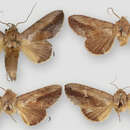Description
provided by Zookeys
Male. (Fig. 13) Head–palp upturned, mahogany brown on basal segment, medial segment with cream scaling along distal margin particularly near terminus; apical segment mostly cream with scattered brown scales. Denuded medial segment 4.1× length of apical segment. Apical segment reduced in size relative to other species in complex. Eye round, large, surrounded tightly with scaling. Front scaling mostly cream with scattered brown scales. Vertex with additional brown scales among white scaling. Scape with cream and brown scaling, white scaling extending onto antennal shaft for about 10–14 segments. Antenna bipectinate basally for 29 segments then with minute basal setae on segments to apex (71 segments). Longest rami 0.34 mm, shortest of all species. Thorax a blend of brown and cream scales giving a tan appearance. Metathorax bearing a central white spot with row of darker brown scales anteriorly. Abdomen with appressed brown scaling. Forewing (17.0 mm, n = 10) elongate, rounded apically and with broad tan subcostal streak from base of wing to apex. Streak encloses chocolate reniform spot and has several slightly darker brown lines crossing obliquely from costa. Basal dash below streak perpendicular to thorax, abbreviated relative to that of Disphragis bifurcata. White streak below dash; warm brown patch distal to white streak bordered by white; AM and PM lines wavy. Chocolate shading from middle of wing below costal streak and forming a wedge to margin (below costal streak to above mid point of margin). Weak gray crescent on lower half of margin. Warm brown from patch expanded almost to margin and reducing size of chocolate wedge seen in Disphragis bifurcata. Hind wing fuscous with darker margin, weak darker brown anal markings almost forming a spot. Underside of forewing fuscous, anal margin and cell yellowish. Basal 3/4 of hind wing yellowish, margin brown and moderately differentiated. Legs a mixture of brown and white scales appearing almost yellowish with white scales forming rings at distal end of tarsal joints. Tibial spines 0-2-4. Male genitalia (Figs 17, 21) (13 dissections). Uncus an extended triangle, rounded apex with setae arranged almost in marginal rows. Tegumen broad, longer than vinculum. Socii extending from base of uncus as two upcurved arms, scythe-like with small, spine-like projections on ventral surface. Degree of spination variable from several to many extending down to angle of socius. Gnathos absent, anal tube unsclerotized. Valve elongated with costal half sclerotized, anal half membranous and enveloping deciduous scent hairs. Valve apex rounded, sclerotized costal half of valva with broad anal projection distally and sharper shelf-like projection basally. Vinculum broad, short and rounded to saccus. Aedeagus long, narrow with basal phallus, proximal 60% unsclerotized with ductus entering medially. Distal 40% of aedeagus sclerotized, enlarged basally at junction with membranous half, and with raised mound of spines ventrally about 1/3 distal from junction. Vesica emerges dorsally from aedeagus, an unsclerotized tube with a long dorsal diverticulum. Cornuti absent. Eighth tergite broadly rounded, slightly sclerotized and crenulated medially at distal end. Eighth sternite lightly sclerotized, broadly rounded with well-defined, broad notch medially, usually broader than in Disphragis bifurcata. Small sac-like flap in middle of sclerite usually in form of narrow crescent, anterior end of sclerite with two broad, rounded projections with medial V-shaped notch. Ctenophores absent on pelt. Female. (Figs 4, 13). Female similar to male only larger (Forewing 20.9 mm, n = 6) and with fasciculate antennae. Female genitalia (Fig. 25) (5 dissections). Papillae anales bluntly rounded, slightly setose. Extension of 9th tergite forming dorsal flap. Anterior apophysis short, 25% as long as posterior apophysis. Genital plate small, elongate, consisting of a bifurcated middle phalanx with lateral “wings” from base. Phalanx somewhat longer than in Disphragis bifurcata. Ductus bursae slightly shorter than corpus bursae, twice as wide as in Disphragis bifurcata and tending to twist, unsclerotized. Corpus bursae egg-shaped with large signum on dorsal side. Signum shield-like, about half as long as corpus bursae. Signum egg shaped with stipulated lateral flanges below midpoint. Proximal margin lightly sclerotized and faintly stippled.
- license
- cc-by-3.0
- copyright
- J. Bolling Sullivan, Michael G. Pogue
- bibliographic citation
- Sullivan J, Pogue M (2014) The Disphragis notabilis (Schaus) species-group in Costa Rica (Lepidoptera, Notodontidae) ZooKeys 421: 21–38
- author
- J. Bolling Sullivan
- author
- Michael G. Pogue
Distribution
provided by Zookeys
This species occurs throughout the Amazon basin from western Venezuela eastward and southward to at least Bolivia.
- license
- cc-by-3.0
- copyright
- J. Bolling Sullivan, Michael G. Pogue
- bibliographic citation
- Sullivan J, Pogue M (2014) The Disphragis notabilis (Schaus) species-group in Costa Rica (Lepidoptera, Notodontidae) ZooKeys 421: 21–38
- author
- J. Bolling Sullivan
- author
- Michael G. Pogue

